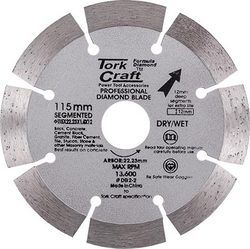Description
A diamond blade is composed of a circular steel core and the diamond impregnated segments. The segments are seperated by slots in the core. These slots assist in cooling the blade during operation by allowing water (wet cutting) or air (dry cutting) to flow between the segments. The segments or rims are a mixture of diamond powder and metal powders. The diamonds are industrial diamonds of different sizes and qualities depending on the material to be cut. The blade works best on concrete. Water will prevent the blade from overheating.
Diamond blade
TYPE: Segmented
DIAMETER: *115mm
BORE: Ø22.23mmmm
MAX RPM: 13,600
USE: Brick, concrete, cement block, granite, fiber cement, tile, stucco, stone and masonry materials. Best results on concrete.
What is a diamond blade?
A diamond blade is composed of a circular steel core and the diamond impregnated segments. The segments are seperated by slots in the core. These slots assist in cooling the blade during operation by allowing water (wet cutting) or air (dry cutting) to flow between the segments. The segments or rims are a mixture of diamond powder and metal powders. The diamonds are industrial diamonds of different sizes and qualities depending on the material to be cut as well a the blade type.
How does a diamond blade work?
The individual diamond crystals exposed on the leading edge and the sides of the segment or rim carry out the cutting. The operator pushes the rotating blade into the material and the surface diamonds thus exposed mill a groove in the material. When the blade mills the material, the latter exerts wear on the blade. During cutting the exposed diamonds may crack or break. The material simultaneously starts to abrade the metal matrix, which releases more diamonds. The more abrasive the material, the more rapid the tendency to wear down the matrix. Blades for cutting hard, denseless abrasive materials (such as tile, bricks, stone or cured concrete), require a softer metal matrix. This will wear down faster, replacing the worn diamonds fairly quickly so that the blade continues to cut. Blades for cutting soft, abrasive materials (such as green concrete and asphalt), must have a hard, abrasion-resistant metal matrix in order to retain the diamonds for a longer time.
Water will prevent the blade from overheating: It will greatly reduce the amount of harmful dust created by cutting. Remove the slurry from the cut, and extend the life of the blade.
